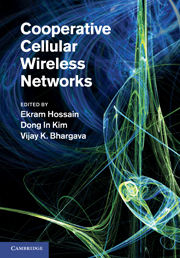Preface
Published online by Cambridge University Press: 03 May 2011
Summary
Cooperative communications and networking represent a new paradigm which uses both transmission and distributed processing to significantly increase the capacity in wireless communication networks. Current wireless networks face challenges in fulfilling users’ ever-increasing expectations and needs. This is mainly due to the following reasons: lack of available radio spectrum, the unreliable wireless radio link, and the limited battery capacity of wireless devices. The evolving cooperative wireless networking paradigm can tackle these challenges. The basic idea of cooperative wireless networking is that wireless devices work together to achieve their individual goals or one common goal following a common strategy. Wireless devices share their resources (i.e., radio link, antenna, etc.) during cooperation using short-range communications. The advantages of cooperation are as follows: first, the communications capability, reliability, coverage, and quality-of-service (QoS) of wireless devices can be enhanced by cooperation; second, the cost of information exchange (i.e., transmission power, transmission time, spectrum, etc.) can be reduced. Cooperative communication and networking will be a key component in next generation wireless networks. In this book we particularly focus on cooperative transmission techniques in cellular wireless networks.
Although cellular wireless systems are regarded as a highly successful technology, their potential in throughput and network coverage has not been fully realized. Cooperative communication is a key technique to harness the potential throughput and coverage gains in these networks.
- Type
- Chapter
- Information
- Cooperative Cellular Wireless Networks , pp. xx - xxviPublisher: Cambridge University PressPrint publication year: 2011

